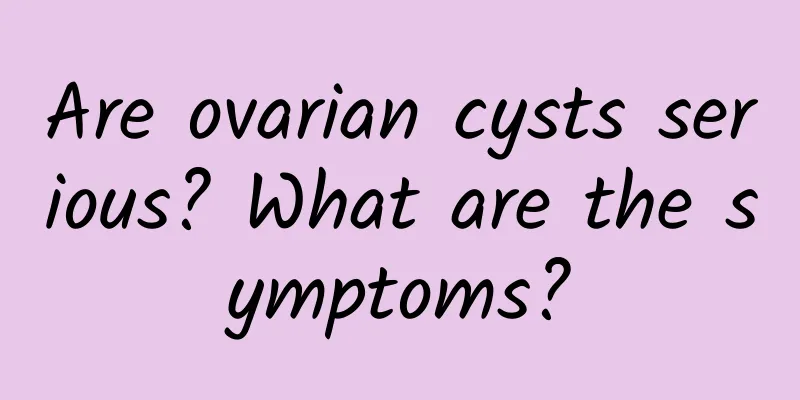Are ovarian cysts serious? What are the symptoms?

|
Ovarian cysts are a gynecological disease that has a great impact on women. They often occur in women of childbearing age and may become malignant. So are ovarian cysts serious? What are the symptoms? Ovarian cysts are quite serious and patients need timely treatment. Patients usually have no obvious symptoms and are often discovered accidentally during physical examinations. Clinically, the disease progresses slowly. As the cyst slowly increases, there are often symptoms such as menstrual disorders, abdominal distension and abdominal pain. When these symptoms are more serious, women are more likely to suffer from ovarian cysts, and the chance and harm of ovarian cancer are greater if the lesion is malignant. The main symptoms of ovarian cysts are: Patients feel that their abdominal circumference has increased and they can feel a mass in the lower abdomen, which is especially noticeable in the morning when they hold their urine and may disappear after urination. Occasionally, they may experience back pain and abdominal distension, and may urinate frequently, but without urinary pain, urgency, or constipation. If the ovarian cyst pedicle is twisted or ruptured, it will manifest as acute abdominal pain, which is a common acute abdomen in clinical visits. Ovarian cyst is a serious gynecological disease. Patients should be treated promptly. The following drugs can be used: Xiaojie'an Capsule: Tongselesailong, Bingnonggannongnei Nongjie, Hunbingnei, Bingban. Traditional Chinese Medicine: Activate blood circulation and remove blood stasis, soften and disperse nodules. Used for breast lumps caused by qi stagnation and blood stasis, breast lobular hyperplasia, ovarian cysts, and uterine fibroids with the above symptoms. Hongjin Xiaojie Capsule: Formerly known as Amonoqi Capsule and Xiaorupi Capsule. The prescription of this medicine is a secret recipe of Yunnan Yi people and is a national secret variety. Guizhi Fuling Capsule: It is a compound preparation made from five Chinese medicinal herbs: cinnamon twig, poria, peony bark, peach kernel, and peony root. It is clinically used for gynecological diseases. |
<<: How to prevent recurrence of adnexitis
>>: What causes pelvic inflammatory disease in women?
Recommend
Adnexitis can be diagnosed through some minor symptoms
Adnexitis can be diagnosed through some minor sym...
Which hospitals are better for treating threatened abortion?
Being able to give birth to a baby smoothly is th...
Lack of hygiene during menstruation is the main cause of pelvic inflammatory disease
Pelvic inflammatory disease is a common gynecolog...
What to eat after abortion of cervical erosion
Cervical erosion harms the patient's health. ...
What should I use to wash my vagina?
Different types of vaginal inflammation require d...
Treatment of cervicitis
Common symptoms of cervicitis are increased leuco...
Ectopic pregnancy may be caused by chronic pelvic inflammatory disease
Ectopic pregnancy may be caused by chronic pelvic...
Eat apples to lower cholesterol! Key: How to take quercetin?
“An apple a day keeps the doctor away” means that...
Can I eat fruit after a miscarriage?
Spontaneous abortion refers to non-artificial abo...
What is the cure rate for threatened abortion?
Threatened abortion, literally understood as a wa...
What should not be eaten for cervical erosion of the third degree
Cervical erosion is one of the common gynecologic...
What are the treatments for female cervical erosion? Female cervical erosion can try traditional Chinese medicine
Patients with cervical erosion are mainly women w...
Wu Qili lost 13 kg by eating only biscuits and tofu
Artists really try every possible means to lose w...
Can female vaginal infection cause cervical erosion? 4 causes of cervical erosion that you should know
In life, it is very important for women to develo...
What causes uterine adnexitis?
Due to the special location of the inflammation a...









